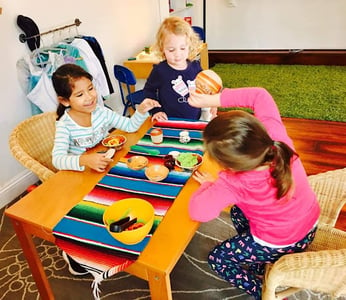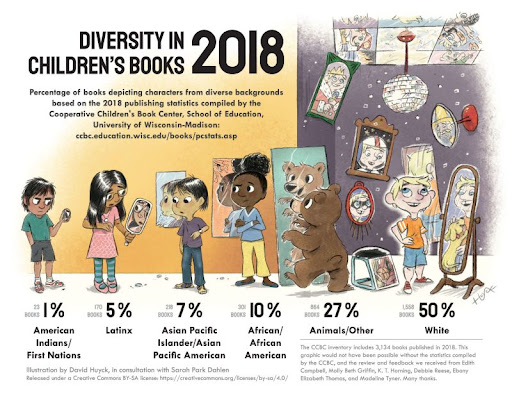
Three reflections that will inspire you to become culturally responsive and make children feel seen, accepted, and recognized.
I moved to the United States years ago when I was a teenager. I felt confused, scared, and out of place in my new school. As soon as I learned English, I decided to stop speaking my native language to hide who I was. I thought that by hiding my identity people would not notice I was different, and accept me.
Over the years I learned that being different is okay and that we are all different in beautiful ways. Recently, I decided to take action, share my story, and create awareness in the teaching community. I hope that by sharing my story I could touch the hearts of teachers and inspire them to create a learning environment that embraces diversity; a place where families and children can feel proud of who they are, the language they speak, the color of their skin, their food, culture, and traditions.
In an increasingly diverse society, it is imperative that teachers are prepared to work with families from different cultural backgrounds. Respecting a diverse group of children means recognizing that all of them are unique in their own ways. Promoting a sense of belonging is key to making families feel welcome and accepted. What can teachers do to support diversity? How can teachers make families feel proud of their home language, food, and traditions?
Reflection One: Why Belonging Matters in the Classroom
According to the UC Berkeley article, “When students experience a sense of belonging in a learning environment, there are both immediate and long-term positive consequences for their academic performance and well-being.” It also indicates that when students don’t feel a sense of belonging, they can become disconnected from their learning environment. It highlights that creating a sense of belonging potentially benefits students from marginalized and stigmatized groups, such as African American, Latino, Native American, first-generation immigrants, and financially stressed students.
This last statement empowers me to create awareness of being culturally responsive and provide opportunities for all students. How do I know my students feel accepted, valued, and seen in my classroom?
Reflection Two: How to Integrate the Culture of the Students in the Curriculum
Families come in different forms, shapes, and structures. Families have unique ideas, values, beliefs, and culture. When I enroll my children in a new program or school, I expect them to feel welcome and loved. As a parent, I will feel very touched if my son’s teachers want to know more about my culture, language, and customs.
We know that children need a safe, loving, and positive environment to feel secure. Teachers demonstrate positive behaviors by engaging in meaningful and caring interactions with families/children. Let’s think about other possibilities…
Reflective Questions:
- How am I promoting a sense of belonging?
- Am I taking into consideration the culture of the family, the language they speak, and their traditions?
- Do I have a protocol or tool that encourages parents to share their culture and embrace culturally diverse families?
Reflection Three: Does Representation in the Learning Environment Matter?
I’m the mother to three young boys. When I read books to them they pick a character that they identify with. They say, “I’m him.” They even argue over who gets to be what character. I notice they look for characters that look like them, their skin color, body type, and other traits. Representation in books, images, materials, and media plays an important role in children’s development and self-esteem. The characters provide a narrative that teaches them about their world.
Do I select books, materials, and images that represent my students’ ethnicities? Do the books, materials, and images promote a positive image of their culture? Please observe this infographic provided by statistics compiled by the librarians at the University of Wisconsin-Madison School of Education Cooperative Children's Book Center CCBC:

Representation plays an important factor in making children feel that their language and culture is appreciated and accepted in their learning community. When selecting books, materials, and images for my classroom, do students have mirrors (opportunities to see themselves and others in these resources)?
Take-Away
\We are all learning how to be culturally responsive and demonstrate to families that we care about their culture. No child or family should be afraid of speaking their native language, wearing their traditional clothing, or telling others their cultural background. Teachers transform, shape, and form children through their genuine care for families. Let’s make it happen! Every child has the right to reach his/her full potential regardless of his/her socioeconomic, cultural, and racial backgrounds.
Featured Image from Di Colori Preschool
 Lenika Flores is an Early Childhood Educator with 21 years in the field, entrepreneur, trainer, and mentor teacher. Lenika has a Bachelor's degree in child development from Point Loma Nazarene University. Lenika has a passion for presenting relevant topics to San Diego Early Years, NAEYC, CAAEYC, Teachstone Summits by sharing stories, anecdotes, experiences, and challenges that her career has given her. Lenika is interested in developing conferences that touch the hearts of teachers and transform their practices to make children feel seen, accepted, and recognized. She ran a preschool called Di Colori for seven years. It was a high-quality program serving her community in South Bay San Diego. The pandemic changed her life and she closed her preschool. Her professional life took a different direction and is currently working at the San Diego YMCA as a Quality Support Manager and her mission is to support early childhood educators improve their programs. Her husband Cesar and three young boys Mati, Manny, and Martin are her motivation.
Lenika Flores is an Early Childhood Educator with 21 years in the field, entrepreneur, trainer, and mentor teacher. Lenika has a Bachelor's degree in child development from Point Loma Nazarene University. Lenika has a passion for presenting relevant topics to San Diego Early Years, NAEYC, CAAEYC, Teachstone Summits by sharing stories, anecdotes, experiences, and challenges that her career has given her. Lenika is interested in developing conferences that touch the hearts of teachers and transform their practices to make children feel seen, accepted, and recognized. She ran a preschool called Di Colori for seven years. It was a high-quality program serving her community in South Bay San Diego. The pandemic changed her life and she closed her preschool. Her professional life took a different direction and is currently working at the San Diego YMCA as a Quality Support Manager and her mission is to support early childhood educators improve their programs. Her husband Cesar and three young boys Mati, Manny, and Martin are her motivation.
